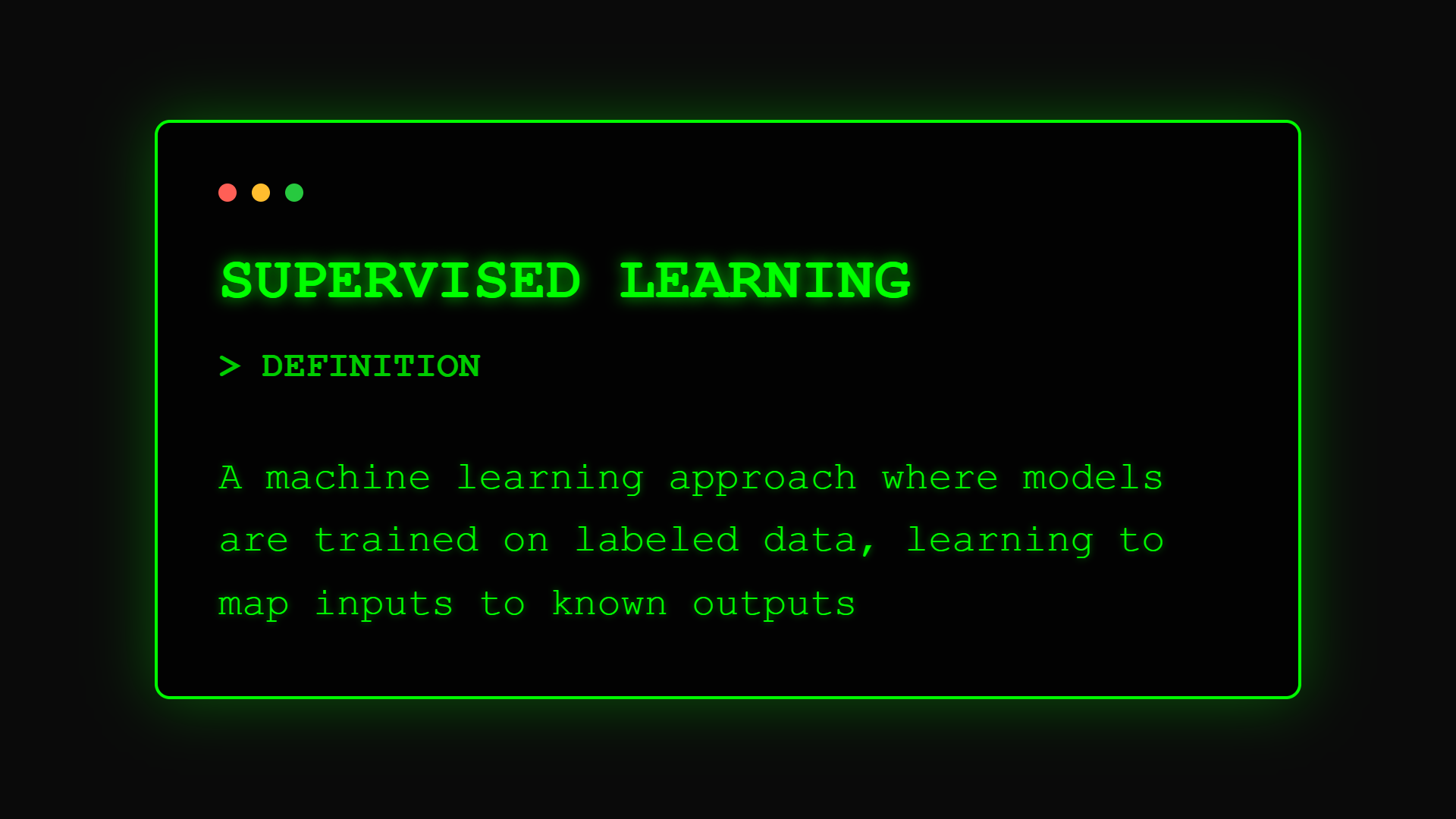AI Terms
What is Supervised Learning? AI That Learns from Examples

Imagine teaching a new employee by showing them thousands of examples: "This is a good customer, this is a risky one." That's supervised learning: the most practical and widely-used form of machine learning, powering everything from spam filters to medical diagnoses by learning from labeled examples.
Origins and Definition
Supervised learning's foundations trace to statistical pattern recognition in the 1960s. The term "supervised" was coined to distinguish it from unsupervised methods, emphasizing the presence of a "teacher" providing correct answers during training.
According to Tom Mitchell's foundational definition, supervised learning occurs when "an algorithm learns a function that maps inputs to outputs based on example input-output pairs." The supervision comes from knowing the correct answer for each training example.
The approach gained practical importance with the rise of digital data in the 1990s, when businesses accumulated enough labeled examples to train effective models for real-world applications.
What It Means for Your Business
For business leaders, supervised learning means training AI systems using your historical data where you already know the outcomes, teaching machines to predict future results based on past examples.
Think of it as apprenticeship training at scale. Just as you'd train a credit analyst by showing them thousands of past loan applications labeled "defaulted" or "repaid," supervised learning trains AI to recognize patterns and make similar decisions on new applications.
In practical terms, this enables automated decision-making for any business process where you have historical examples: approving loans, detecting fraud, forecasting sales, or identifying customer churn risks.
Essential Components
Supervised learning consists of these essential elements:
• Training Data: Historical examples with known outcomes like past transactions labeled fraudulent/legitimate, customers who churned/stayed, products that succeeded/failed
• Features: The input variables that might predict outcomes. For customer churn: usage patterns, support tickets, payment history, engagement metrics
• Labels: The known correct answers for training examples, the "supervised" part showing what the model should predict
• Algorithm: The mathematical method that finds patterns like decision trees for interpretability, neural networks for complexity, regression for continuous values
• Model: The learned pattern extractor, a mathematical function that can predict labels for new, unseen examples
The Training Process
The supervised learning process follows these steps:
Data Preparation: Collect historical examples with known outcomes, selecting relevant features and ensuring labels are accurate, like gathering past sales data with factors that influenced success
Training Phase: The algorithm analyzes examples to find patterns linking features to labels, discovering that customers who contact support 3+ times in the first month have 70% churn rate
Prediction Phase: Apply the trained model to new data without labels, using learned patterns to predict outcomes, flagging current customers likely to churn based on their behavior patterns
The key is having enough quality examples that represent the full range of scenarios the model will encounter in production.
Two Main Types
Supervised learning generally falls into two main categories:
Type 1: Classification Best for: Categorizing into groups like fraud/legitimate, churn/retain, buy/not buy Key feature: Predicts discrete categories or classes Example: Email spam filters learning from messages marked spam/not spam
Type 2: Regression Best for: Predicting numeric values like prices, scores, quantities Key feature: Outputs continuous numerical predictions Example: House price prediction based on size, location, and features
Common Algorithms:
- Linear Models: Simple, interpretable, fast, good for clear relationships
- Tree-Based: Handle non-linear patterns, provide feature importance
- Neural Networks: Complex patterns but require more data
- Support Vector Machines: Effective for high-dimensional data
Supervised Learning in Action
Here's how businesses actually use supervised learning:
Banking Example: American Express uses supervised learning for fraud detection, training on millions of labeled transactions to identify suspicious patterns, catching 90% of fraud while reducing false positives by 50%.
Retail Example: Target's demand forecasting uses supervised learning trained on historical sales, weather, and promotional data to predict product demand, reducing excess inventory by 30%.
Healthcare Example: Mount Sinai Hospital uses supervised learning trained on patient records to predict disease onset 6 months early with 84% accuracy, enabling preventive interventions.
Next Learning Steps
Ready to implement supervised learning in your business?
- Compare with Unsupervised Learning for pattern discovery
- Explore Reinforcement Learning for optimization tasks
- Understand the foundation with Machine Learning
- Start implementation with our Supervised Learning Playbook
FAQ Section
Frequently Asked Questions about Supervised Learning
Part of the [AI Terms Collection]. Last updated: 2025-01-10